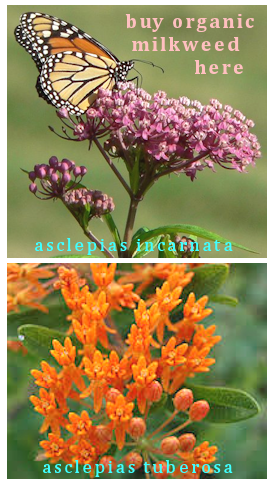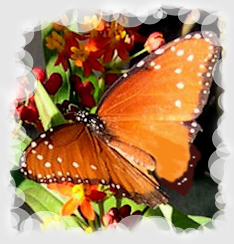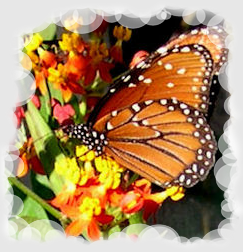Growing Asclepias
 Asclepias, commonly known as Milkweed, or Butterfly weed, is relatively easy to grow, providing the seed is fresh. I will be discussing starting Asclepias curassavica, commonly known as Tropical milkweed.
Asclepias, commonly known as Milkweed, or Butterfly weed, is relatively easy to grow, providing the seed is fresh. I will be discussing starting Asclepias curassavica, commonly known as Tropical milkweed.
Asclepias curassavica is one of the warmer growing species of asclepias, and is well known for attracting the esteemed monarch butterfly to draw from it's nectar filled miniature flowers.
 Mine seem to do well in a sunny location that gets slight protection from the strongest rays of the afternoon sun. When planted out, it enjoys a sandy soil with compost and peat added, making sure it drains well. It can also tolerate some dryness, after becoming established.
Mine seem to do well in a sunny location that gets slight protection from the strongest rays of the afternoon sun. When planted out, it enjoys a sandy soil with compost and peat added, making sure it drains well. It can also tolerate some dryness, after becoming established.
If you are able, acquiring a plant first is a sure deal in getting fresh seed later. The butterflies it will attract will easily pollinate the plant, leaving you with sickle shaped plump green pods that ripen to a nice brown and then burst open when ripe. Getting a handful or two of the fluff topped seeds before the breeze carries them away ensures you that a brand new crop of new asclepias will be in the works for the following season.
Asclepias is a perennial, and will come back for you each year if you live in zones 8 and 9. I live in zone 10A, and protect mine from the very few light frosts we have, so the plant bed never really dies down. If you live in zone 8, protect the bed with a deep covering of straw or mulch, to keep the tender roots and crown from frost and possible freeze.
 After acquiring the fresh seed, sow it on the top of a prefilled starter pot, about 3 inches wide by approximately 4 inches deep. Use a soil mix of 1/4 well rotted cow manure compost, 1/2 part crushed peat, 1/4 part perlite. Add appropriate amount of micronutrient beads (Osmocote is good) to the mixture and stir in well. Then mix in some sand until you can just see it.
After acquiring the fresh seed, sow it on the top of a prefilled starter pot, about 3 inches wide by approximately 4 inches deep. Use a soil mix of 1/4 well rotted cow manure compost, 1/2 part crushed peat, 1/4 part perlite. Add appropriate amount of micronutrient beads (Osmocote is good) to the mixture and stir in well. Then mix in some sand until you can just see it.
Pre-wet the soil when in the pots, before adding the seeds. Then and only then add the seeds, 2 or 3 to a pot. Barely cover the seeds with soil, some light on the seed is alright. When watering, mist lightly and from now on you must keep the soil moist, but not soaking, until the seedlings come up. Dust some Cinnamon or Cornmeal on the surface if fungus gnats become an issue.
Germination can take anywhere from 2 weeks to a month, depending upon your conditions. That includes light, water, and temperature, as well as your soil mix.
Because these plants are being grown for butterflies, I use organic fertilizers and sea kelp powder mixes to keep them healthy and so as not to put anything untoward into the butterflies.
When the plants are about 6 inches tall, and the roots are beginning to peek out the bottoms of their cups, plant them out in the preprepared soil mixture described above. Water them in the mornings to prevent wet leaves during the hottest part of the day.
If you live in zones 9, asclepias curravisca (shown above) should have it's feet mulched in fall, and it will die back after the first frost. But it will return in spring. In zone 10, the plant will survive the winter, continuing to grow and flower.
 The ripe seedpods burst open without notice, so look daily after they reach a size of about 2 inches or so, and feel them for ripeness. If you press slightly and the vertical seam pops, pick the pod off to save the seeds from the winds and allow you to harvest.
The ripe seedpods burst open without notice, so look daily after they reach a size of about 2 inches or so, and feel them for ripeness. If you press slightly and the vertical seam pops, pick the pod off to save the seeds from the winds and allow you to harvest.
Red and black asclepias bugs can often be found on the pods. Remove them with a burst of water if you like. They suck the juices from the pods, but just a few are not harmful. I notice the ants like to tend to yellow aphids just under flower clusters. They can also be removed with a blast from the hose. Be careful when waterblasting pests. Remember, Monarchs and Queen butterflies use these plants for laying eggs and feeding their caterpillars, so closely inspect the area you are getting ready to hose before doing it. I actually cup my hand behind the flower head in question before hitting it with the water, to be sure the water blast is gentle, but thorough.
Tags: grow milkweed, Asclpeias, monarch weed, butterfly weed, butterly plant, butterfly attractant, nectar plants, asclepias curassavica

